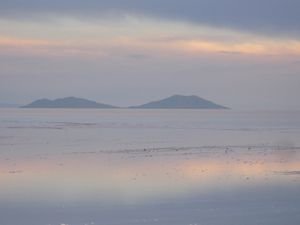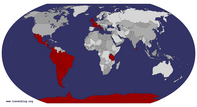Advertisement
Published: April 2nd 2008

 Uyuni Colours
Uyuni Colours
Just before sunset there were lovely colours over the salt flats. We planned to travel from Tupiza to Uyuni by train but we got so tired of waiting for the ticket office in the station to open that we gave up and booked a bus instead. This meant we left Tupiza at a better time of day but we did sacrifice comfort for timing and price! The trip to Uyuni took about 6.5 hours by bus, a difficult journey along unpaved roads, leaving me bruised and battered, a trip that I wouldn't wish on my worst enemy. I think we'd been spoiled by all our nice bus journeys in Argentina!
But we got there in the end, it was still daylight and despite it being Easter weekend, everything in Uyuni was open and we had no problem finding a hotel or booking a tour to the salt flats for Easter Sunday, the following day. Just like in Tupiza, the central area was full of backpackers, backpacker restaurants and backpacker tour agencies, while the outskirts was where you saw the local's Uyuni! In parts of Argentina we had often gone days without seeing fellow travellers, but in Tupiza and especially Uyuni, it felt like we were following some

 Ruth Balancing
Ruth Balancing
Ruth meets a giant bottle of Nivea on the Salarsort of gringo trail. Well if you can't beat them join them! That night we went to the famous Minuteman Pizza restaurant in Uyuni, run by an American expat, and described by many guidebooks and travellers as the best pizza place in South America. It did live up to expectations and we ate there on all three evenings (plus one mornng) of our stay.
Most visitors to Uyuni do the 4 day tour of the salt flats but we preferred a shorter visit and booked instead a one day tour. There are a good 30 to 40 agencies in Uyuni offering Salar tours making it hard to know whom to pick. In the end we followed the guidebook's advice and choose Andes Salt Expeditions who had one day tours for 25 USD per person.
So next morning we assembled at the offices, and met our fellow group members: Graham from Australia and a Brazilian/Bolivian couple, Wilson & Ennelie (not sure if these last two spellings are correct). We had a great guide called Santos, a very friendly and informative guy, who hailed from Potosi. The first stop was the main sight in Uyuni town - the train cemetery.

 Uyuni Train Cemetery
Uyuni Train Cemetery
One of the hundreds of rusting train parts in the train cemetery. This is a fascinating sight, full of ancient, rusting engines, the view of which outlined against the mountains in the background, makes for wonderful pictures! Santos outlined the history of the railways in Bolivia before letting us explore (i.e. climb up on and take silly pictures of) the trains.
We then drove north towards Colchani, a small settlement on the edge of the salt flats. Just before reaching it, we spotted some wild vicuna near the road so Santos pulled over to let us take pictures and to tell us a bit about the animals. So we've now seen three of the four South American camelids: guanaco, llama and vicuna - with only alpacas remaining.
The Salt Farms of Colchani Colchani is where every tour group stops to have a look at the market and the small museum. Santos had other ideas though, first taking us to visit a small family run salt farm. As soon as we arrived about 6 kids walked out to greet us. They were quite curious and shy so perhaps this place doesn't get many visitors. The farm is run by Pedro and his wife, who seem to have a huge family as
more and more kids kept appearing during the tour. Santos asked him all sorts of questions - in fact, I thought he asked too much as poor Pedro had to tell us how many hours he worked, how much he earned, how long he'd been doing the job, and much more. His farm is just one of a number in Colchani, and what they do is gather the salt from the salar, process it with minerals (basically iodizing it) to make it safe to eat, then package it into 1kg bags and sell it on. He receives 8 Bolivianos (about 1 USD) for each 1 kg bag, which later sells in the towns for about 15 or 16 Bs.
His wife was a lovely lady, though Santos also subjected her to the "how many hours, how much pay" routine. Can you imagine a group of people you've never met before showing up and asking you all these questions? Pedro and his wife didn't seem to mind; for the record she works from 8am till 8pm bagging the salt, with one day off a week. I got the feeling some of her kids might do this work too when tourists

 Uyuni Clock Tower
Uyuni Clock Tower
Most if not all visitors to Uyuni come to see the salt flats but the town too is a nice enough place with some attractive buildings like the clock tower. aren't around. The kids were running everywhere, including walking barefoot over the iodized salt - so remember if you buy a bag and it tastes like smelly feet, there's a good explanation! They also make and sell souvenirs made from salt, so I bought one of these though it was more of a thank you for the tour than something I wanted. Visiting this farm was an eye opening experience, an interesting way of seeing how the locals live, far more informative than some of the tourist trap stops that lay ahead.
The next stop was one of these tourist traps. We pulled into the main square in Colchani, where about 10 other 4x4s had also stopped, and Santos led us into a museum, which contained animal figures such as condors and llamas made from salt. He told us more about the town then left us alone to wander around. On the way out we were hit by a museum entrance fee of 5 Bs. In most places you pay entry beforehand but I guess they can guarantee the income by getting you in there then charging a the end! It only cost about half a euro but it

 Salt Farmers
Salt Farmers
The lady in the picture works 12 hours a day bagging the iodized salt into 1Kg bags.was the principle of it! One of the things I loved about Colchani was the big mounds of salt you see everywhere - many houses had gardens full of salt.
As I said, Colchani lies on the edge of the salar, so after leaving town we were soon on the brilliant white salt flats. What a sight it was! The first stop was the section where the salt farmers gather their loads so it was full of striking pyramids of salt (like a farmer bailing hay), extremely scenic. December to March is the rainy season in Bolivia and in this part of the Salar there were plenty of puddles but it made for even better pictures.
Onto the Island We drove 80 km across the salt flats towards Isla Incahausi, one of the many islands in the middle of the Salar. I spent most of the trip just gazing in awe at the beautiful white surroundings, spoiled only by our Aussie friend's constant chatter. He was quite a character with some great stoires but I think I'd have liked to change places after a while! The Salar measures about 10000 square kilometres, and as everything around is white,

 Salar de Uyuni Group
Salar de Uyuni Group
Santos & our other group members by the jeep.navigation is not easy. Santos used Volcan Tunapu to the north and another Volcano to the west as his guides and we reached the island after an hour. There are a number of islands in this area and stopping at one of them is a standard part of any tour. It looked like we had to ourselves until we drove around to the west of the island where about 30 jeeps were parked!
A trail lead to the top of this cactus covered island so we clambered up - at the top, according to Wilson's watch, the altitude was 3740 metres, making it one of the highest points we've walked to, though I'm not sure we can count this one as it was only about 50 metres of ascent. The island is covered in cactus, which looks stunning against the backdrop of the "sea" of salt. At the top you can gaze out in any direction and it's white salt as far as the eye can see! The island is run by two communities from the edge of the salt flats who charge 10 Bs for the visit.
We then had lunch down near the jeep, a very

 Isla Incahausi
Isla Incahausi
Isla Incahuasi is a popular stop in the middle of the salar. It is covered in cacti which look spectacular against the backdrop of the sea of salt. tasty meal of llama, quinoa and salad. An important part of any trip to the salt flats is taking those silly photos so with a sprite bottle, some suncream and two teddy bears we passed a fun hour on the flats. On the way back we stopped quickly at the salt hotel, though Ruth and I wanted to take more silly pictures so we skipped most of the tour inside.
So after that it was back to Uyuni though we did have one more stop before leaving the salar for sunset pictures. I thought we'd never beat the sunset we saw at Valle de la Luna in San Pedro de Atacama but this one ran it close. The colours and reflections on the salt were simply stunning. The beauty of a one day tour was we were back in Uyuni for dinner, a delicious meal of Pizza and Bolivian wine in the Minuteman pizza place!
We stayed one more day in Uyuni, it was mostly a "work" day: i.e. burning DVDs, getting the washing done, writing blogs and planning the next part of our trip, though we did find time to see the train cemetery again. We decided
to visit in the afternoon when the light was better. It was easy to get there - just follow the train tracks for 3km. Unfortunately, just like in Uyuni, the area outside Uyuni was used as something of a rubbish dump: We had to hold our noses for about 1km between town and the train cemetery. It's such a pity that the beautiful landscape is ruined like this, there is so much tourist money coming into Uyuni that it would be nice to see some put towards proper garbage disposal!
We left the heights of Uyuni and moved onto even greater heights - Potosi, the world's highest city!
Advertisement
Tot: 0.08s; Tpl: 0.012s; cc: 8; qc: 24; dbt: 0.0421s; 1; m:domysql w:travelblog (10.17.0.13); sld: 1;
; mem: 1.1mb
























Sarah
non-member comment
Photos
Great photos here, especially the sunsets and the salt pyramids, but I confess I'm puzzled by how you made the trick ones with the Sprite bottle!